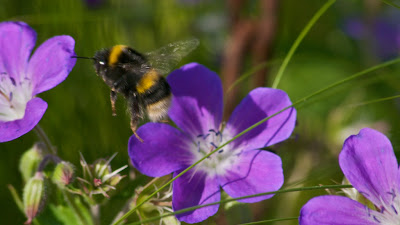In amongst the geraniums (f5.6 @ 1/250s, 1000 ISO)
I'm still a beginner when it comes to aerial photography. I don't have any fancy equipment. Just my regular camera.
f5.6 @ 1/160s, 200 ISO, 300mm lens - 450mm 35mm equivalent
You should use a fast shutter speed if you don't want their wings to appear blurry - bees apparently flap their wings at about 230 times per second. However, the picture above (top) was taken at 1/250 of a second and the wings are still blurred.
Bee battles the side wind amongst the cherry blossom at Kew Gardens
(f7.1 @ 1/400s, 100 ISO, 190mm lens - 285mm equivalent)
If you don't mind blurry wings (I think they can look more dynamic) use a smaller aperture (f5.6 - f11) to increase your depth of field (the amount that is in focus in the picture), as it will give you more chance of getting one in focus.
Landing on Linaria
(f13 @ 1/250s, 400 ISO, 300mm lens - 450mm equivalent)
(f13 @ 1/250s, 400 ISO, 300mm lens - 450mm equivalent)
Trouble is, if you do both of those things you will need to increase your ISO or shoot on a very sunny day. Sadly a high ISO can make your pictures appear grainy or noisy (on some point and shoot cameras, anything above 400 ISO can be noisy, on most DSLRs you can take shots at 1600 ISO with barely noticeable grain). Good luck with the sunny day.
Deutzia Mont Rose
(f10 @ 1/800s, 400 ISO, 300mm lens - 450mm equivalent)
(f10 @ 1/800s, 400 ISO, 300mm lens - 450mm equivalent)
Coming in to land on our Deutzia Mont Rose
(f5.6 @ 1/200s, 1000 ISO)
Deutzia is particularly attractive to bumblebees, although it only lasts in flower for about two weeks, it is covered with bees for much of that time (late May-early June).
f5.6 @ 1/320s, 250 ISO, +0.7EV, 190mm lens - 285mm equivalent
Honey bee with Aster
(f5.6 @ 1/250s, 250 ISO, +0.3EV, 300mm lens - 450mm equivalent)
A Penstemon looks like a Foxglove and is almost as attractive to bees
(f16 @ 1/160s, 400 ISO, 300mm lens - 450mm equivalent)
f4.5 @ 1/200s, 250 ISO, +0.7EV, 190mm lens - 285mm equivalent
When you are close to the subject, as with this bumblebee amongst the geraniums, even a narrow aperture will give you shallow depth of field
(f14 @ 1/250s, 400 ISO, 300mm lens - 450mm equivalent)
f7.1 @ 1/400s, 400 ISO, 190mm lens - 285mm equivalent














No comments:
Post a Comment